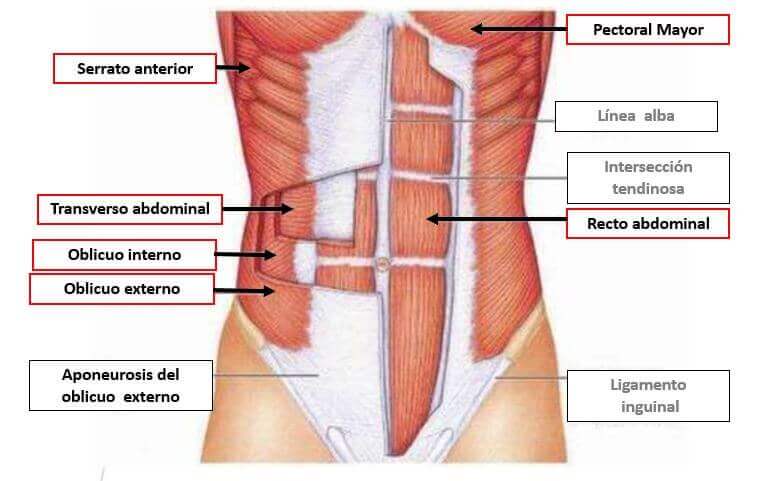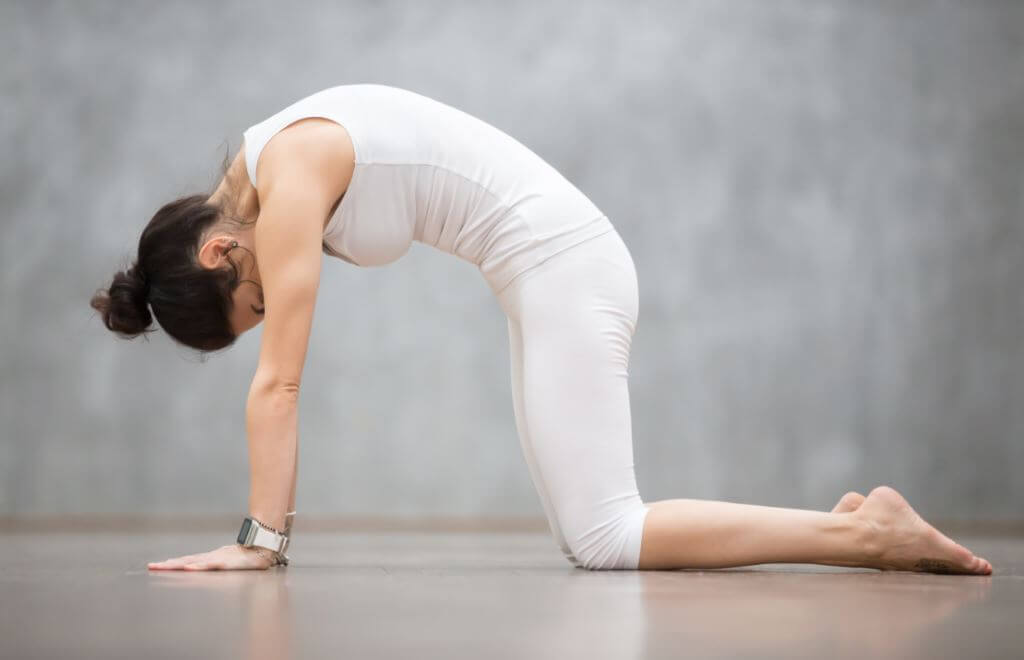Transverse Abdominal Muscle: Easy Exercises to Get Fit

Most people exercise their abs for aesthetic reasons. Under this training dynamic, they often forget to exercise the transverse abdominal muscle. However, strengthening this area can bring great benefits to your whole body.
There are many exercises to work your transverse abdominal muscle. One of the most common is the ab crunch. Basically, you tighten your abs and lift your trunk up towards your legs. Then, slowly lay down again.
However, this isn’t the only exercise you can do to strengthen the transverse abdominal muscle. In this article, we’ll explain some great movements and postures you can do to strengthen your core.
What is the transverse abdominal muscle?
The transverse abdominal muscle is located in the body region known as the core. To be more precise, this is the area that connects the back and the abdomen, all around the waist. It’s a really important muscle in the human body.
The main function of the transverse abdominal muscle is to support the trunk. Its most specific function is to protect the lumbar vertebrae and the entire abdominal area. In this way, it provides support and stability to the upper part of the spine.

Transverse abdomen muscle: three ways to work it
Strengthening your transverse abdominal muscle will straighten your back and improve your posture. In addition, enhancing its strength and flexibility has a considerable impact on the development of other muscle groups. By having a strong core you’ll be able to do more challenging workout routines.
1. Plank: the basic exercise to work the core
The plank allows us to train the abdominal area while at the same time working out other muscle groups. To do the plank, the first thing you need to do is place yourself on the mat as if you’re going to start doing push-ups. Keep your hands right below your shoulders.
However, if this position is too hard for you, you can always bend your elbows and rest on your forearms. If you do this, make sure your elbows are right below your shoulders.
Keep your body in a straight line from your shoulders to your feet. Place the tips of your toes on the floor, supporting your weight. After you achieve the right position, the only thing you have to do is hold it for 30 seconds. Lower your body and then repeat the exercise as many times as you can.
We can also do side planks to exercise the obliques. To do this exercise, hold your body up with one forearm while lying on your side. If you need a visual reference, just take a look at the cover image of this article.
The upper arm should be fully extended over your body, and this will be central to maintain the correct posture. Do 30 to 45 seconds on one side, and then change sides. If you can hold the position for longer, that’s great! Just remember to do the exact same time on each side to balance your workout.
2. Cat pose: quadruped to work the core
The transverse abdominal muscle can be worked easily with postures that involve both hands and legs as support. One of the basic postures is the cat pose, common in yoga even for beginners. The trick to do the cat pose right is to balance your weight among all four extremities.
Begin with your back relaxed, keeping it straight in a neutral position. Remember, the objective of this exercise is to flex the spine outward. Start bowing your back, and as you do, pull your head down between your shoulders. Stretch the neck and the back well while you hold the position. Slowly relax and return to your initial position.

You can work this exercise through hypopressive resistance. Basically, this means you should keep the position without doing repetitions, rather holding it for as long as you can before relaxing. We recommend doing repetitions of between 8 to 10 seconds in the beginning. With practice, you’ll be able to hold this up to one minute.
3. Hip lift to strengthen your transverse abdominal muscle
In the same way, you can work lying on your back with your knees moderately bent. In this exercise, your shoulders are against the floor and your arms are extended to the sides. The hands remain palms down, and you’ll use them to support yourself.
The central movement consists of lifting your hips from the floor as high up as you can. In this position, you should tighten your abs and pelvic muscles to maintain balance, in a way that will directly impact the transverse muscle of the abdomen.
This exercise can also be done by holding the position, just as you did with the cat pose. However, we also recommend doing repetitions, as these will work your abs even further. This is a common exercise in many pilates routines, commonly practiced in gyms.
Of course, you need to know that almost all abdominal exercises involving elevation of the legs and not the trunk strengthen this muscle. Doing leg work while lying on the floor and keeping your trunk straight, demands a strong core. In this sense, we recommend trying some Pilates movements that focus on this area.
As you can see, strengthening your transverse abdominal muscle is necessary if you want to be able to increase the pace and demand of your abs routines. In addition to this, the different positions we present also generate aesthetic benefits in the core.
Most people exercise their abs for aesthetic reasons. Under this training dynamic, they often forget to exercise the transverse abdominal muscle. However, strengthening this area can bring great benefits to your whole body.
There are many exercises to work your transverse abdominal muscle. One of the most common is the ab crunch. Basically, you tighten your abs and lift your trunk up towards your legs. Then, slowly lay down again.
However, this isn’t the only exercise you can do to strengthen the transverse abdominal muscle. In this article, we’ll explain some great movements and postures you can do to strengthen your core.
What is the transverse abdominal muscle?
The transverse abdominal muscle is located in the body region known as the core. To be more precise, this is the area that connects the back and the abdomen, all around the waist. It’s a really important muscle in the human body.
The main function of the transverse abdominal muscle is to support the trunk. Its most specific function is to protect the lumbar vertebrae and the entire abdominal area. In this way, it provides support and stability to the upper part of the spine.

Transverse abdomen muscle: three ways to work it
Strengthening your transverse abdominal muscle will straighten your back and improve your posture. In addition, enhancing its strength and flexibility has a considerable impact on the development of other muscle groups. By having a strong core you’ll be able to do more challenging workout routines.
1. Plank: the basic exercise to work the core
The plank allows us to train the abdominal area while at the same time working out other muscle groups. To do the plank, the first thing you need to do is place yourself on the mat as if you’re going to start doing push-ups. Keep your hands right below your shoulders.
However, if this position is too hard for you, you can always bend your elbows and rest on your forearms. If you do this, make sure your elbows are right below your shoulders.
Keep your body in a straight line from your shoulders to your feet. Place the tips of your toes on the floor, supporting your weight. After you achieve the right position, the only thing you have to do is hold it for 30 seconds. Lower your body and then repeat the exercise as many times as you can.
We can also do side planks to exercise the obliques. To do this exercise, hold your body up with one forearm while lying on your side. If you need a visual reference, just take a look at the cover image of this article.
The upper arm should be fully extended over your body, and this will be central to maintain the correct posture. Do 30 to 45 seconds on one side, and then change sides. If you can hold the position for longer, that’s great! Just remember to do the exact same time on each side to balance your workout.
2. Cat pose: quadruped to work the core
The transverse abdominal muscle can be worked easily with postures that involve both hands and legs as support. One of the basic postures is the cat pose, common in yoga even for beginners. The trick to do the cat pose right is to balance your weight among all four extremities.
Begin with your back relaxed, keeping it straight in a neutral position. Remember, the objective of this exercise is to flex the spine outward. Start bowing your back, and as you do, pull your head down between your shoulders. Stretch the neck and the back well while you hold the position. Slowly relax and return to your initial position.

You can work this exercise through hypopressive resistance. Basically, this means you should keep the position without doing repetitions, rather holding it for as long as you can before relaxing. We recommend doing repetitions of between 8 to 10 seconds in the beginning. With practice, you’ll be able to hold this up to one minute.
3. Hip lift to strengthen your transverse abdominal muscle
In the same way, you can work lying on your back with your knees moderately bent. In this exercise, your shoulders are against the floor and your arms are extended to the sides. The hands remain palms down, and you’ll use them to support yourself.
The central movement consists of lifting your hips from the floor as high up as you can. In this position, you should tighten your abs and pelvic muscles to maintain balance, in a way that will directly impact the transverse muscle of the abdomen.
This exercise can also be done by holding the position, just as you did with the cat pose. However, we also recommend doing repetitions, as these will work your abs even further. This is a common exercise in many pilates routines, commonly practiced in gyms.
Of course, you need to know that almost all abdominal exercises involving elevation of the legs and not the trunk strengthen this muscle. Doing leg work while lying on the floor and keeping your trunk straight, demands a strong core. In this sense, we recommend trying some Pilates movements that focus on this area.
As you can see, strengthening your transverse abdominal muscle is necessary if you want to be able to increase the pace and demand of your abs routines. In addition to this, the different positions we present also generate aesthetic benefits in the core.
All cited sources were thoroughly reviewed by our team to ensure their quality, reliability, currency, and validity. The bibliography of this article was considered reliable and of academic or scientific accuracy.
- Álvaro Robín Valle de Lersundi; Arturo Cruz Cidoncha. Anatomía y fisiología de la pared abdominal. Extraído de: https://www.berri.es/pdf/MANUAL%20DE%20CIRUGIA%20DE%20PARED%20ABDOMINAL%20COMPLEJA/9788416706549
- Víctor Segarra; Juan Ramón Heredia; Guillermo Peña; Matías Sampietro; Mauricio Moyano; Fernando Mata; Felipe Isidro. 2014. Core y sistema de control neuromotor. Extraído de: http://www.scielo.br/pdf/rbefe/2014nahead/1807-5509-rbefe-1807-55092014005000005.pdf
This text is provided for informational purposes only and does not replace consultation with a professional. If in doubt, consult your specialist.








